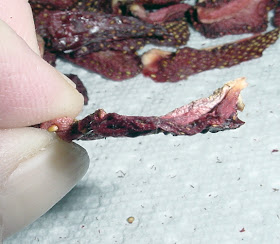This week strawberries started showing up at a couple of Floyd's road side stands. They aren't Floyd county strawberries yet but they are close to home. Just south of Floyd the Blue Ridge Mountains drop abruptly into North Carolina. It's a steep escarpment that appears dramatically in sight whether your approach is by air into Roanoke, driving north up Interstate 77, or actually weaving your way up to Floyd from the south on one of the many back roads or Rt 8. This sudden drop in altitude allows Patrick County, our immediate neighbor just a few miles to the south, to be in a much warmer growing zone. Thus, they bring many of their fruits to our markets 2-3 weeks ahead of our own Floyd County fruit.
I start preserving (and eating!) strawberries as soon as they show up. I freeze, dehydrate, jam, and whole preserve in syrup. This post will cover dehydrating and freezing, the two simplest preservation methods for strawberries. Strawberry jam, leather, and whole strawberry preserves will have their own posts.
Freezing
Nothing could be simpler than freezing strawberries or berries of any kind. Remove the green caps, gently wash your berries, drain well, and dry by laying out the berries on clean kitchen towels or a couple of layers of paper toweling. Allow them to air dry for a bit. The less damp the berries are when you freeze them, the less ice crystals there are to damage the quality during cold storage. Next, lay the berries in a single layer on cookie sheets and slide them into the freezer. Check on them in 2 hours. If the berries haven't frozen solid in that time, return to the freezer and check on them regularly until they are. Once they are frozen remove the berries from the sheet into the freezer bag or container of your choice. I prefer good heavy zip-lock freezer bags. When the bag is full, I zip it nearly shut, insert a straw and suck out as much air as possible, and then zip it shut while sucking. That's my poor man's vacuum sealer! It works pretty well for my purposes. Getting out as much air as you can helps to discourage freezer burn. Label and date your bags and store in the freezer. That's it! That's all there is to it!
Dehydrating
Dehydrating is only slightly more complicated. Follow the directions above for cleaning your strawberries. Next, you are going to want to either slice or quarter the berries. Most directions say to slice them 1/4" thick for drying. I did that last year and I felt the strawberries were rather shard-like. Nothing wrong with them, just shard-like. So this year I decided to try quartering them. I did a tray of sliced as well as the quartered berries for comparison.
If you don't have a dehydrator you can do this in your oven on it's lowest setting with the door ajar. Be aware that the temperature will be much higher than a dehydrator's 135F. You will have to watch them closely and remove them when completely dry. Some people set up a fan to blow into the oven to keep the air circulating better. Lay the berries on cookie sheets preferably lined with a silicone mat, or with wax or parchment paper.
Large berries got quartered and smaller berries got cut in half through the broadest part
They were laid on the screen cut side up.
If you are slicing your berries you can do it by hand with a paring knife being sure to cut slices as much the same size as possible. Or you can use one of these: |
| Butter pat slicer |
When you've got all your berries sliced, lay them out on racks or sheets and into the the dehydrator set at 135F or the lowest temperature on your oven. They can take anywhere from 7-14 hours to dry in the dehydrator depending on the thickness, the moisture content of the berries, and the humidity of the day. Check at 7 hours in the dehydrator. If you are drying in the oven check much sooner and more often.
When the berries feel dry (not sticky and not flabby), remove them and allow to cool completely. Check them again. They should not be sticky and while the chunks may be slightly flexible, they will not feel flabby or squishy. Slices may be flexible, but they may also be stiff and snap when bent.
 |
| Dried slices |
 |
| Thickness of a dried slice |
 |
| Dried quarters and halves |
 |
| Thickness of a dried quarter |
Don't be surprised by how small your pile of dried berries looks. They pack a concentrated flavor and sweetness punch! I dehydrated approximately 4 pints and they filled my strawberry jar a little less than half way. When this jar is full, it'll give me enough dried strawberries for a winter's worth of snacks, muffins, scones, granolas, and strawberry vinaigrettes.







No berries here for another month, but I just got a new food dehydrator so I can't wait to give dried strawberries a try!
ReplyDelete